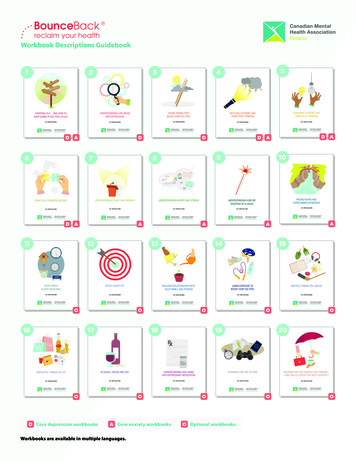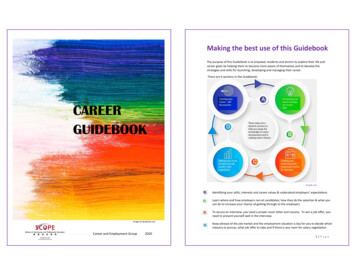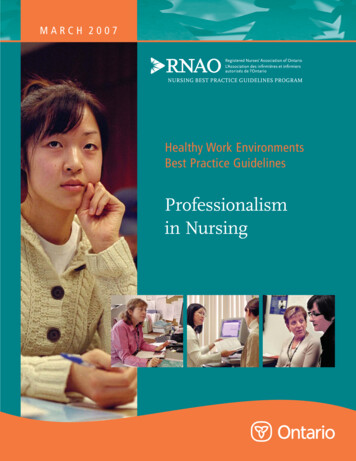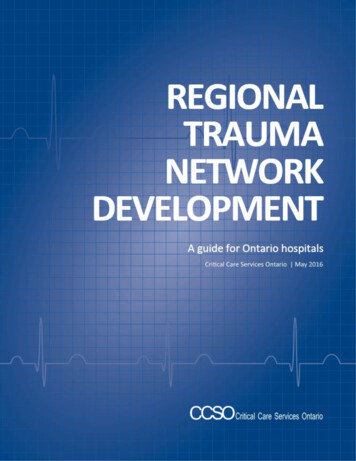
Transcription
Workbook Descriptions Guidebook12354STARTING OUT . AND HOW TOKEEP GOING IF YOU FEEL STUCKUNDERSTANDING LOW MOODAND DEPRESSIONDOING THINGS THATBOOST HOW YOU FEELNOTICING EXTREME ANDUNHELPFUL THINKINGCHANGING EXTREME ANDUNHELPFUL THINKINGDR. CHRIS WILLIAMSDR. CHRIS WILLIAMSDR. CHRIS WILLIAMSDR. CHRIS WILLIAMSDR. CHRIS WILLIAMSDA6D7DDPRACTICAL PROBLEM SOLVINGUNDERSTANDING PANIC AND PHOBIASUNDERSTANDING WORRY AND STRESSUNDERSTANDING HOW WERESPOND TO ILLNESSDR. CHRIS WILLIAMSDR. CHRIS WILLIAMSDR. CHRIS WILLIAMSDR. CHRIS WILLIAMSDA11A12FACING FEARS ANDOVERCOMING AVOIDANCEDR. CHRIS WILLIAMSAAA131415OVERCOMINGSLEEP PROBLEMSBEING ASSERTIVEBUILDING RELATIONSHIPS WITHYOUR FAMILY AND FRIENDSUSING EXERCISE TOBOOST HOW YOU FEELHELPFUL THINGS YOU CAN DODR. CHRIS WILLIAMSDR. CHRIS WILLIAMSDR. CHRIS WILLIAMSDR. CHRIS WILLIAMSDR. CHRIS WILLIAMSOO1716O18A1098DAO19O20 UNHELPFUL THINGS YOU DOALCOHOL, DRUGS AND YOUUNDERSTANDING AND USINGANTI-DEPRESSANT MEDICATIONPLANNING FOR THE FUTUREINFORMATION FOR FAMILIES AND FRIENDS—HOW CAN YOU OFFER THE BEST SUPPORT?DR. CHRIS WILLIAMSDR. CHRIS WILLIAMSDR. CHRIS WILLIAMSDR. CHRIS WILLIAMSDR. CHRIS WILLIAMSOOD Core depression workbooksA Core anxiety workbooksWorkbooksare available in multiple languages.1OO Optional workbooksOO
You’ve made the decision to refer your clients to the BounceBack telephonecoaching program. That’s great! They are going to benefit from the programby learning new skills to help them better manage their symptoms of mild tomoderate depression and anxiety.To help you and your clients better understand how the program works and howthe program can help them make practical changes in their lives, take a look atthe course topics included in this booklet. Discuss them with your clients anduse this booklet as a guide to help them identify (check off ) any problem areasthey are interested in working on with the support of a BounceBack coach. WhileBounceBack coaches are working with your clients on their individual workbooks,you continue to remain clinically responsible for their care.Good luck!2
During the three to six months that it typically takes for participants tocomplete the BounceBack program, they will usually work through three to fourworkbooks. They will generally start by working through the following workbooks:All participants will receive the introductory workbook: Starting out and how to keep going if you feel stuckLearn: How to make a clear plan of how and when to use this and other workbooks. How to anticipate and overcome any difficulties that could get in the way ofcompleting the workbooks.Participants interested in tackling depression, will receive the introductory workbook: Understanding low mood and depressionLearn: How low mood affects five key areas of your life. How making a change in one area can lead to a change in another to helplift your low mood and help you deal with feeling low or stressed.EXAMPLEPaul is feeling depressed and struggling with work. The figure below shows how Paul’sproblems can be summarized using the Five Areas Approach.AREA 1: SITUATIONS, RELATIONSHIPS AND PRACTICAL PROBLEMSOff work, may be fired, arguments with partner, not enough money.AREA 2: ALTERED THINKING”I’m failing at everything,”“I shouldn’t be feeling like this”,“I can’t cope”, I should be working”,“I’m going to get fired.”AREA 3: ALTERED FEELINGS/EMOTIONSLow, down, anxious,stressed, guilty.AREA 4: ALTERED PHYSICALSYMPTOMS/BODILY SENSATIONSTired, can’t sleep or relax,exhausted.AREA 5: ALTEREDBEHAVIOUR/ACTIVITYDoing less and less,arguments with Helen, tearful.3
Participants interested in tackling anxiety, can choose from three introductory workbooks,depending on their self-reported issue: BILLSUnderstanding worry and stressLearn:PAST How worry or stress affects five key areas of your life.DUE Which area you need to work on to overcome your anxiety problems.EXAMPLEHelen is struggling with worry about debt. The figure below shows how Helen’s problemscan be summarized using the Five Areas Approach.AREA 1: SITUATIONS, RELATIONSHIPS AND PRACTICAL PROBLEMSNot able to pay her bills each week. Money worries building up.AREA 2: ALTERED THINKING”I‘m going to be kicked outof my apartment.”AREA 3: ALTERED FEELINGSAnxious and stressed.AREA 4: ALTERED PHYSICALSYMPTOMSFeels tense and restless.Can’t sleep at night.AREA 5: ALTERED BEHAVIOURStarts to drink and smoketo try and feel better. 4Understanding panicand phobias Understanding how werespond to illnessLearn:Learn: How to identify the early warning signsand unhelpful thinking that can lead topanic attacks or phobias so that you cando something about them before thingsget worse. How you respond to illnessand the unhelpful thinkingand behaviours you use thatmake you feel even worse. Helpful things you can do to change.
Once participants complete the initial workbooks, they can choose from 14 other workbooks. Here are the topicsavailable that they and their coach can select from based on the participants’ current needs and changes they areinterested in making.If interested in making changes to behaviours and activity levels, considerworkbooks on: Facing fears andovercoming avoidance Learn: Steps you can take to tackle your fears andovercome avoidance. Unhelpful things you doLearn:Learn: Which activities you cando that give you a boost,and ideas on how to make sure youdo these things, even when you are busyor under stress. Why you feel like avoiding things that seemscary, and understand how avoidance canactually make you feel worse. Helpful things you can do Doing things that boost howyou feel How some unhelpfulbehaviours can makeyou feel better in the short term, but in thelong run, can backfire and make you andothers feel worse.Learn: How to identify and change theseunhelpful behaviours. How to carry out a step-by-step planthat’s realistic in helping you incorporateregular activities back into your life. How low mood and stress cancause you to do less, and how byincreasing activity levels you canboost how you feel.Using exercise toboost how you feelLearn: How exercise can improveyour mood, and help you feelfitter, more active, and better aboutyourself. How to plan more exercise into your life.5
If interested in making changes to negative and upsetting thinking,consider workbooks on: Noticing extreme andunhelpful thinkingChanging extreme andunhelpful thinkingLearn:Learn: How unhelpful thinking canaffect how you feel and what you do. About your own thoughtprocess and the differentapproaches you can use to deal withextreme and unhelpful thinking beforeit becomes too upsetting. Which unhelpful styles of thinking youmight fall into and how to responddifferently.6
If interested in making changes to do with situations, people and events aroundyou, consider workbooks on: Practical problem solvingLearn: A seven-step plan on howto approach a problem sothat it becomes easier to solve.We all face difficulties in life; what’sdifferent is how we deal with them. Building relationshipswith your family and friendsLearn: A bout your own styles of communicatingor relating to others, and how to build(or rebuild) relationships with the peopleclose to you.Being assertiveLearn: The differences betweenpassive and aggressivebehaviours and some simpletechniques you can use to be moreassertive in your own life. Information for familiesand friends – how canyou offer the best support?Learn: What the BounceBack program isall about and how the person beingsupported is using it. Helpful things you can do to offer thebest support possible.7
If interested in making changes to things that affect your bodily well-being,consider workbooks on: Overcoming sleepproblemsLearn: To identify what things arepreventing you from getting agood night’s sleep, and some changesyou can make to help overcomesleep problems. Understanding andusing anti-depressantmedicationLearn: More about the use of anti-depressantsfor depression, as well as some usefultips to get the most out of yourmedication.8 Alcohol, drugs and youLearn: About the effects that alcoholand drugs can have on you andthe people around you, and howto plan some next steps to bring aboutchange if you have a problem.
Once participants have gone through all of the workbooks they are interested incompleting, they will receive a final workbook for their last coaching call. This willhelp them maintain and build on the progress they have already made. Planning for the futureLearn: How to manage how you feelmoving forward by: identifying what’spreviously helped; making a plan to stay well;tracking your progress; and identifying earlywarning signs that may indicate that you areslipping back to old habits.Booster sessionsFor participants who are looking for further support or to reinforce the new skills theyhave just learned, one or two booster sessions are available with their coach within six monthsof completing the BounceBack program.9
NOTES:10
NOTES:11
About the Canadian Mental Health Association (CMHA) OntarioIncorporated in 1952, CMHA Ontario provides community-based programsand services across the province to meet the needs of individuals seekingsupport with their mental health and addictions. Our 30 local CMHAbranches are part of a community-based mental health sector whichservices approximately 500,000 Ontarians annually.For more information about CMHA Ontario, visit www.ontario.cmha.caAbout the authorDr. Chris Williams is a medical doctor and psychiatrist who also has aFirst Class Honours degree in Psychology. He is a widely recognized teacherand researcher in the area of cognitive behavioural therapy self-help and isEmeritus Professor of Psychosocial Psychiatry at the University of Glasgow,Scotland, UK. He is also Director of Five Areas Ltd (www.fiveareas.com).BounceBack materials are adapted with permission from Dr. Chris Williams andused under licence.
Being assertive Learn: The differences between passive and aggressive behaviours and some simple techniques you can use to be more assertive in your own life. Building relationships with your family and friends Learn:










